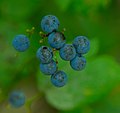Caulophyllum thalictroides
Caulophyllum thalictroides, also known as blue cohosh, is a species of flowering plant in the Berberidaceae family. It is native to eastern North America, from Manitoba and Oklahoma east to the Atlantic Ocean.
Description
Caulophyllum thalictroides is a perennial herbaceous plant that grows up to 60 cm tall. It has blue-green leaves and produces small, greenish-yellow flowers in the early spring. The fruit is a blue berry.
Habitat and distribution
Caulophyllum thalictroides is found in hardwood forest and on the edges of woods. It prefers rich, moist, well-drained soils. Its range extends from southern Canada to the southern United States.
Uses
Caulophyllum thalictroides has been used in traditional medicine by Native Americans for a variety of ailments. It has been used as a uterine stimulant, to induce labor, and to treat menstrual disorders. However, its use is not recommended due to potential toxicity.
Cultivation
Caulophyllum thalictroides is cultivated as an ornamental plant for its attractive foliage and berries. It is suitable for shade gardens and woodland plantings.
Toxicity
All parts of Caulophyllum thalictroides are toxic if ingested. The plant contains several alkaloids, including caulophylline, which can cause nausea, vomiting, and in severe cases, organ damage.
Conservation
Caulophyllum thalictroides is not currently considered threatened or endangered. However, due to its specific habitat requirements and slow growth rate, it may be vulnerable to habitat loss and overharvesting.
See also
Transform your life with W8MD's budget GLP-1 injections from $125.
W8MD offers a medical weight loss program to lose weight in Philadelphia. Our physician-supervised medical weight loss provides:
- Most insurances accepted or discounted self-pay rates. We will obtain insurance prior authorizations if needed.
- Generic GLP1 weight loss injections from $125 for the starting dose.
- Also offer prescription weight loss medications including Phentermine, Qsymia, Diethylpropion, Contrave etc.
NYC weight loss doctor appointments
Start your NYC weight loss journey today at our NYC medical weight loss and Philadelphia medical weight loss clinics.
- Call 718-946-5500 to lose weight in NYC or for medical weight loss in Philadelphia 215-676-2334.
- Tags:NYC medical weight loss, Philadelphia lose weight Zepbound NYC, Budget GLP1 weight loss injections, Wegovy Philadelphia, Wegovy NYC, Philadelphia medical weight loss, Brookly weight loss and Wegovy NYC
|
WikiMD's Wellness Encyclopedia |
| Let Food Be Thy Medicine Medicine Thy Food - Hippocrates |
Medical Disclaimer: WikiMD is not a substitute for professional medical advice. The information on WikiMD is provided as an information resource only, may be incorrect, outdated or misleading, and is not to be used or relied on for any diagnostic or treatment purposes. Please consult your health care provider before making any healthcare decisions or for guidance about a specific medical condition. WikiMD expressly disclaims responsibility, and shall have no liability, for any damages, loss, injury, or liability whatsoever suffered as a result of your reliance on the information contained in this site. By visiting this site you agree to the foregoing terms and conditions, which may from time to time be changed or supplemented by WikiMD. If you do not agree to the foregoing terms and conditions, you should not enter or use this site. See full disclaimer.
Credits:Most images are courtesy of Wikimedia commons, and templates, categories Wikipedia, licensed under CC BY SA or similar.
Contributors: Prab R. Tumpati, MD












